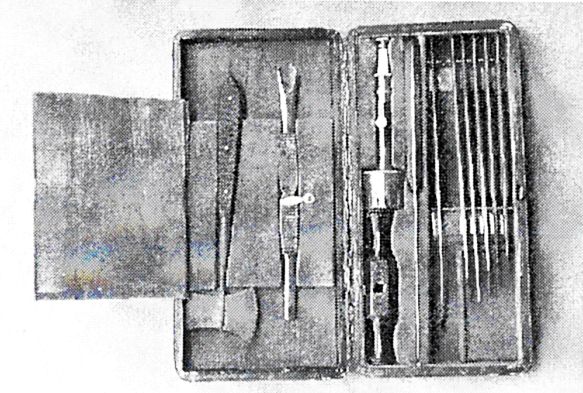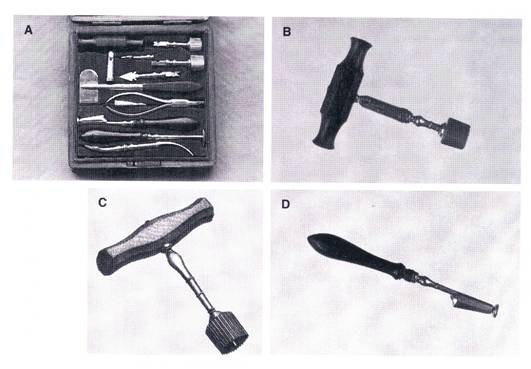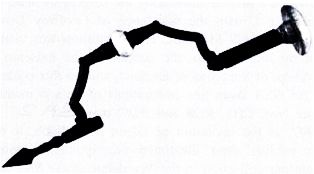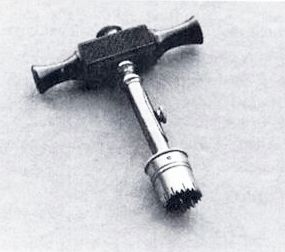
South Australian Medical Heritage Society Inc
Website for the Virtual Museum
Home
Coming meetings
Past meetings
About the Society
Main Galleries
Medicine
Surgery
Anaesthesia
X-rays
Hospitals,other organisations
Individuals of note
Small Galleries
Ethnic medicine
- Aboriginal
- Chinese
- Mediterran
Important Collection of Neurosurgical Instruments
from South Australia
ACKNOWLEDGMENTS: We are most grateful to Emeritus Neurosurgeon (RAH & WCH) Professor Donald Simpson AO for allowing us to view the catalogue and his publication of the same in the Journal of Neurosurgical Science. (Clin Neurosci 2003 10(6) 715-716) He also contacted the Neurosurgical Society of Australasia (NSA) and obtained from Stacie Gull to copy some of his figures and photographs.
As a curator, Professor Simpson has been responsible for maintaining and cataloguing the collection of important neurosurgical instruments displayed in the Dinning Neuroscience Library at the Royal Adelaide Hospital in Adelaide. The suggestion to assemble such a collection was first made by K.G. Jamieson at the Perth meeting of the NSA. He also made the first donation, an early 19th century case containing a trephine and skull saw.
Numerous donations of early neurosurgical instruments followed. Many were from past presidents of the NSA, and their pupils. Noted neurosurgeons, such as Hugh Trumble, Antony James, Leonard Lindon. Rex Money, Douglas Miller also contributed generously. to the collection. Some items were their personal instruments. Many items represent the influence of Harvey Cushing (1969-1939) an American neurosurgeon on Australian neurosurgery. Instrument manufacturers such as Down Bros, Aesculap and Medtronic also contributed.
The catalogue contains many important references to Sir Hugh Cairns (1896-1952) who was born in Port Pirie in South Australia and commenced his medical studies in Adelaide. This collection has been exhibited in Adelaide at several Australasian and international meetings.
Quite recently (July 2009) the Executive Committee of the NSA decided to move the collection to the Royal Australasian College of Surgeons in Melbourne. While some persons may regret this, the storage facilities and potential for greater access are cogent reasons for such a move. It seems no different from the co-location of important Impressionist collections in the Cortauld and Phillips galleries in London and Washington. Both can be accessed by the internet but personal attendance is a unique experience. The same will presumably apply to the neurosurgical collection.
The following items have been copied from Professor Simpson’s catalogue and his publication in the Journal of Clinical Neuroscience. The entries contain a precise description of the source, history and function of each item.
The alpha numeric codes define the instrument types. Some 95 instruments are described and classified as above. In each instance the item’s source, history and use is described by the curator
INDEX OF INSTRUMENTS
Instrument categories Braces, burrs, perforators and trephines. |
Alphanumeric code BR
|
The alpha numeric codes define the instrument types. Some 95 instruments are described and classified as above. In each instance the item’s source, history and use is described by the curator

 A donation to the collection made by Professor Simpson in 1975. A trephine set with skull saw and other instruments believed to be of 18th century BritIsh manufacture.
A donation to the collection made by Professor Simpson in 1975. A trephine set with skull saw and other instruments believed to be of 18th century BritIsh manufacture.
A= set in shagreen case:
B= trephine and handle assembled.
C=similar trephine figured by Percival Pott.
D= the lenticular, an instrument used to scrape bone edges.
SC 4
Dissection scalpel used by Hugh Cairns as a medical student.
Not in previous catalogue
This nickel plated solid forged scalpel is inscribed “1912 U of A (University of Adelaide). Hugh Cairns Scalpel Anat. School” The inscription is written on a white material, perhaps zinc oxide.It is believed that the scalpel was given by Cairns to his class mate Albert Ray Southwood (1894-1973). later a distinguished honorary physician in the Royal Adelaide Hospital. Southwood evidently preserved the scalpel as a memento of his friend.
In 19th century English Medical Schools, anatomy was usually taught by practising surgeons, who dissected cadavers with ebony handled scalpels in general surgical use. The advent of thermal sterilization around 1890 made ebony unsuitable for surgery, but John Kirkup (personal communication 23 Nov. 2005) notes that Down’s catalogue in 1892 still offered ebony handled scalpels for anatomical dissection. By 1906 Down also offered solid forged scalpels for dissection. Scalpels with disposable blades later entered anatomy schools, but solid forged scalpels were used as late as the 1940s, and in 1944 a popular textbook offered students guidance on how to sharpen their scalpels with carborundum stone2.
Cairns entered the Adelaide Medical School in 1912 and studied anatomy under the famously eccentric Professor Archibald Watson (1849-1940), whose teaching Cairns greatly admired. Cairns was only 15 when he began his course; he was a good student, usually obtaining first class passes. He took time off in May 1915 to serve as a private in the 3rd Australian General Hospital during the Gallipoli campaign. He resumed his course in April 1916, and graduated top of his final year in June 1917, the youngest of his class and a Rhodes Scholar. He then rejoined the Australian Army Medical Corps as a captain, and served in France.1
Maker not known.
Donor Richard Southwood FRCS(Eng), orthopaedic surgeon and son of AR Southwood, 29 November 2005.REFERENCES
1 Fraenkel GJ Hugh Cairns. Oxford University Press 1991. pp 4-11.
2 Grant JCB. A method of Anatomy.Baltimore. Williams &
Wilkins 3rd ed. 1944. P xxii.Entry in the catalogue referring to Sir Hugh Cairns and his early medical career.
Braces, burrs, perforators and trephines
BR1: Brace and perforator, 17th century (Fig. 1)

This French instrument is made of iron and ivory. Presumably the perforator, which is detachable, was changed for a trephine or a burr once the bone had been penetrated. Burrs and rounded drill points had been described by Berengario da Carpi (c1460-1530),2 and the use of a brace for trephination is doubtless much older. This neat little brace, only 20.6 cm from the socket for the perforator to the ivory handle, is typical of continental European braces, at a time when English surgeons tended to favour gimlet handles for trephination.
Maker: The maker's name, Bonnerout of Montpellier, is engraved on the holder of the perforator. Montpellier has been a leading centre of French medicine since the 12th century AD, if not earlier

The trephine is made of a steel cylinder about 21 mm. In diameter, with serrations and also slots to allow bone dust to escape; this device is credited to Benjamin Bell (see BR2). The trephine has a retractable centring point; the shank is made of brass. All these beautifully made instruments had ebony handles. After about 1890 the use of steam sterilization made ebony handles unsuitable, although conservative surgeons were slow to accept this.
-o0o-